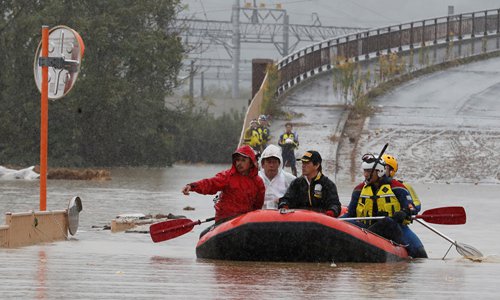HOME >> WORLD
Japan to use 6.5 million USD from reserves to finance post-typhoon disaster relief
Source:Xinhua Published: 2019/10/16 22:10:30

Rescue workers transport a resident in the aftermath of Typhoon Hagibis near the Chikuma River in Nagano Prefecture, Japan on Monday. The super typhoon has caused severe floods, killing 58 people and injuring more than 200 as of press time. Photo: VCG
Japan will use around 710 million yen (6.5 million dollars) from the national budget's 2019 reserve fund to help finance disaster relief efforts following a powerful typhoon over the weekend, Japanese Prime Minister Shinzo Abe said Wednesday.
Speaking at an Upper House Budget Committee meeting, the Japanese leader said that the emergency funds will be dispersed to finance emergency transportation of relief supplies, including water, food and makeshift shelters for those still displaced.
The Cabinet Office said that as of Wednesday, around 4,400 people still remained displaced and are being categorized as evacuees. They are currently staying at 188 temporary shelters, the office said.
Abe also said the funds will be used to help bolster personnel on the ground dealing with the aftermath of Typhoon Hagibis, the most powerful typhoon to hit Japan in decades, and one which claimed the lives of at least 74 people.
The Japanese premier said that searches were still continuing for more than a dozen people still missing and said that the numbers of those engaged in emergency missionsaround the clock, comprising firefighters, self-defense force personnel (SDF), coast guard members and police has totaled around 110,000 individuals.
Plunging temperatures and rain forecast in the coming days, however, means that potential rescue searches will likely turn into recovery missions as the critical 72-hour period after the disaster first struck has passed.
The Japan Meteorological Agency (JMA) said Wednesday it forecasts heavy rain from Friday through Saturday across regions in eastern and northeastern Japan. Not only will the inclement weather hamper relief and cleanup operations, the likelihood of further landslides will increase in mountainous or hilly areas that have already been inundated with water, officials warned.
While damaged levees are being fixed and temporary ones being used to ensure flooding in hard-hit areas remains contained, as pump trucks battle to drain the water, temporary levees are also being installed at the numerous rivers that have bursts their banks around the country.
The infrastructure ministry said Wednesday that embankments had collapsed at 79 locations along 55 rivers, as the full extent of the damage begins to become clearer. The number of collapsed embankments had risen from 74 announced a day earlier.
Local and central government officials, however, are still finding it hard to fully assess the level of damage caused in some regions hardest-hit by the typhoon, as muddy flooded areas have been difficult for officials to gain access to in some areas, despite pump trucks being deployed to help rectify the situation.
Abe said the government would continue with a plan to fully survey the affected regions with an aim to determining whether they could be designated as "suffering from a serious disaster," which would enable the government to dispatch further funds to those areas in particular.
"We will make the utmost effort so the disaster victims can return to their lives without worries as soon as possible," the prime minister, who also said he plans to visit some of the hardest-hit regions on Thursday, said.
He said he wishes to hear the opinions and needs of those who are suffering in the wake of the typhoon and to ensure they have all the relief goods they need.
Abe said he will visit disaster-hit regions in Miyagi and Fukushima prefectures on Thursday and wants to grasp the extent of the damage for himself.
Japan's northeast region, yet to fully recover from a massive earthquake-triggered tsunami in 2011, was particularly hard hit by Typhoon Hagibis, with 26 deaths registered in Fukushima alone, making it the region with the highest death toll among all of Japan's 47 prefectures.
RELATED ARTICLES:
Posted in: ASIA-PACIFIC